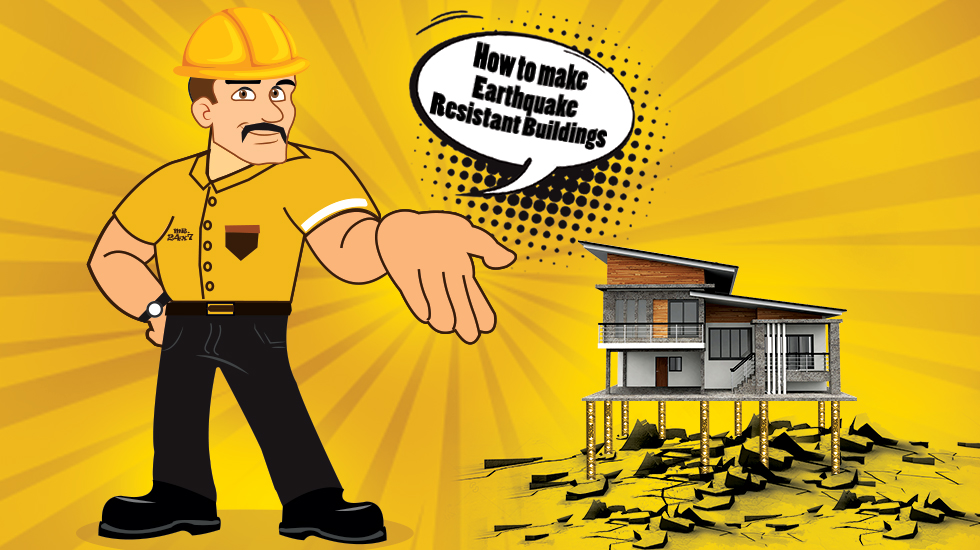How to make Earthquake resistant buildings

Bureau of Indian Standards (BIS) has categorized the seismic zones into four levels based on the intensity of earthquakes:
Seismic Zone | Intensity |
II | VI & Below |
III | VII |
IV | VIII |
| V | XI & Above |
Most of the cities and towns in India fall under Seismic Zones III, IV and V. This indicates an increased focus on earthquake resistant construction in the country.
- Zone V: The areas under zone V are most vulnerable to earthquakes; Entire northeastern India, parts of Jammu and Kashmir, Himachal Pradesh, Uttaranchal, Rann of Kutch in Gujarat, part of North Bihar and Andaman & Nicobar Islands.
- Zone IV: Remaining parts of Jammu and Kashmir and Himachal Pradesh, National Capital Territory (NCT) of Delhi, Sikkim, Northern Parts of Uttar Pradesh, Bihar and West Bengal, parts of Gujarat and portions of Maharashtra near west coast and Rajasthan.
- Zone III: Kerala, Goa, Lakshadweep islands, remaining parts of Uttar Pradesh, Gujarat and West Bengal, Parts of Punjab, Rajasthan, Madhya Pradesh, Bihar, Jharkhand, Chhattisgarh, Maharashtra, Orissa, Andhra Pradesh, Tamil Nadu and Karnataka.
- Zones II: Other parts of India.
Majority of devastation caused by earthquakes is a result of inadequate or poor construction practices or not following standard procedures / protocols. The extent of damage during an earthquake depends largely on the construction practices that are followed in that region. Such calamities challenge our incompetent designs and the materials put in constructing the structures. India witnessed a series of catastrophic earthquakes in the past few decades. As a matter of fact, our government has implemented strict construction measures and improved its standards to build earthquake-resistant buildings in the areas prone to an earthquake or seismic activity.
Below mentioned are some recommendations, adherence to which can help us building better and ensure earthquake resistant buildings; thereby preventing damage to life.
Using materials which display bendability without breaking:
Using material with better bendability will make building absorb shock and enable it to withstand seismic activities. This is indeed possible by using TMT bars in place of conventional bars. 24K TMT bars mark to be an excellent choice. Our TMT bars exhibit a soft inner core and a strong outer shell. As a result of this, our bars exhibit amazing shock absorbing properties. 24K TMT bars are high grade bars which will ensure safety of the complete structure.
Avoiding load bearing structures:
Load-bearing structures do not aid much when a seismic shock is felt. These structures are not earthquake resistant. We would recommend avoiding usage of load bearing structures and instead opt for 24K TMT bars which are strong and result in making a much more stable structure.
Using light weight yet strong building materials:
The energy which generates due to an earthquake is huge and is directly proportional to the height and mass of a building. More massive the structure more will be the energy absorbed. Using light weight yet strong building materials help to absorb and distribute the energy whenever an earthquake strikes. This measure saves the building from demolishing due to the seismic activity.
Opting for thin concrete floors:
Building small but reinforced concrete stripes in the walls at various levels like lintel, plinth and roof helps stand a seismic shock. These infill walls develop cracks under severe ground shaking / seismic activity, but they help to share the load of beams and columns until cracking. These stripes should ideally run horizontally through the walls in order to bind all the components of building together. Using high quality building materials in creating the RC frame (Beams and columns) and these walls goes without saying. All the partitions and walls should be made thin and light yet strong. This makes the complete structure stronger and shock resistant too. On the other hand, light material will make energy absorption and dissipation even.
 Call 96445 55556
Call 96445 55556